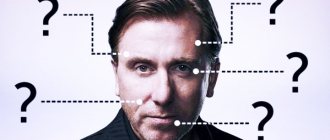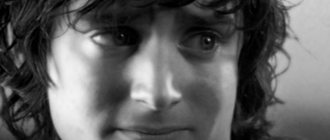DEFINITION OF CHARACTER
CHARACTER
is a set of personality properties that determine typical ways of responding to life circumstances.
Character
- this is a set of stable personality traits that determine a person’s attitude towards people and the work performed. Character is manifested in activity and communication (like temperament) and includes what gives a person’s behavior a specific, characteristic shade (hence the name “character”).
Character can be found in the characteristics of the activities that a person prefers to engage in. Some people prefer the most complex and difficult activities; for them it is a pleasure to seek and overcome obstacles; others choose the simplest, hassle-free paths. For some, it is important with what results they completed this or that work, whether they managed to surpass other people. For others, this may not matter, and they are content with the fact that they did the job no worse than others, achieving mediocre quality.
When communicating with people, a person’s character is manifested in his behavior, in the way he responds to people’s actions and actions. The manner of communication can be more or less delicate, tactful or unceremonious, polite or rude. Character, unlike temperament, is determined not so much by the properties of the nervous system as by a person’s culture and upbringing.
A person’s character is what determines his significant actions, and not random reactions to certain stimuli or prevailing circumstances. The action of a person with character is almost always conscious and deliberate, and can be explained and justified, at least from the position of the actor. When talking about character, we usually put into our idea of it a person’s ability to behave independently, consistently, regardless of circumstances, showing his will and perseverance, determination and perseverance. A characterless person in this sense is one who does not show such qualities either in activity or in communication with people, goes with the flow, is dependent on circumstances, and is controlled by them.
In its formation, development and functioning, a person’s character is closely related to temperament. The latter represents the dynamic side of the character. Character, like temperament, is quite stable and little changeable.
There is a division of human personality traits into motivational and instrumental. Motivational
encourage, direct activity, support it, and
instrumental ones
give it a certain style.
Character can be considered one of the instrumental personal properties. It is not the content that depends on it, but the manner in which the activity is performed. True, as was said, character can also be manifested in the choice of the goal of action. However, when the goal is defined, the character acts more in its instrumental role, i.e. as a means to achieve a goal. 4 pp., 1737 words
According to MDK 03.02 Methodology for organizing various types of activities, ...
... educational institution "Novokuznetsk Pedagogical College" MDK 03.02 Methodology for organizing various types of activities, communication and education of children with mental retardation and speech deficiencies "Training ... our home 17. Furniture 18. Family 19. School, school supplies 20. Professions of people 21 Winter, New Year 22. Defender of the Fatherland Day 23. Spring, March 8...
Let us list the main personality traits that make up a person’s character
.
Firstly,
These are those personality properties that determine a person’s actions in choosing the goals of activity (more or less difficult).
Here, rationality, prudence, or the qualities opposite to them can appear as certain characterological traits .
Secondly,
The character structure includes traits that relate to actions aimed at achieving set goals:
perseverance, determination, consistency and others,
as well as alternatives to them (as evidence of a lack of character).
In this regard, character comes closer not only to temperament, but also to the will of a person.
Third,
character includes purely instrumental traits directly related to temperament:
extraversion-introversion, calmness-anxiety, restraint-impulsiveness, switchability-rigidity, etc.
What is temperament
The term comes from the Latin temperamentum - “proportionality”, “proper proportion of parts”. For the first time, the “father of medicine” Hippocrates spoke about temperament in the 3rd-4th centuries BC. It was he who first formulated four types of temperaments that have come down to us almost unchanged: sanguine, choleric, melancholic and phlegmatic.
So what is this “proportionality” and “combination of parts” according to Hippocrates? The ancient Greek scientist believed that there are four main fluids or juices in the human body: blood, bile, mucus and black bile. It is they and their combinations that determine temperament. According to Hippocrates it looked like this:
- blood predominates in the body of a sanguine person;
- a choleric person has the most bile in his body;
- the phlegmatic temperament determines a large amount of mucus;
- A melancholic person has the most black bile.
Some of my readers probably smiled: what kind of mucus and black bile? Of course, modern science has long moved away from such concepts.
It was the “father of medicine” Hippocrates who first spoke about temperament.
Now temperament is a type of higher nervous activity . It determines the speed of reactions of the human nervous system. Few people know, but the types of nervous activity were determined by the Russian scientist Ivan Petrovich Pavlov during the famous experiments with conditioned reflexes. This is where the dogs were given food after the light came on.
The scientist replaced blood, mucus and bile with other concepts: strength, balance and mobility of the nervous system. The combination of these qualities determines a person’s temperament.
I’ll simplify it a little, and at the same time summarize the above.
So, temperament is a certain rhythm of your interaction with external stimuli. It depends on the strength, balance and mobility of the nervous system.
And now I will move directly to the description of the types of temperament.
CHARACTER BUILDING
IN
To what extent is a person’s character stable? Some character traits that are stable throughout a person’s life are already found in young children, for example, preschoolers. This means that the origins of a person’s character and the first signs of its stabilization should be sought at the very beginning of life.
The main role in the formation and development of a child’s character is played by his communication with people around him. In his characteristic actions and forms of behavior, the child first of all imitates his close adults. With the help of direct learning through imitation and emotional reinforcement, he learns the forms of adult behavior.
The sensitive period of life for the development of character can be considered the age from 2-3 to 9-10 years, when children actively and extensively communicate both with surrounding adults and with peers, are open to outside influences, readily accept them, imitating everyone and in everything. At this time, adults enjoy the child’s unlimited trust and have the opportunity to influence him with word, deed and action, which creates favorable conditions for reinforcing the desired forms of behavior.
The style of communication between adults with each other in front of a child, the way they treat him himself is very important for the development of character. This especially applies to the treatment of parents with a child, primarily the mother. The way a mother and father act towards a child many years later becomes the way he treats his children when the child becomes an adult and starts his own family.
Before others, such traits as kindness, sociability, responsiveness, as well as their opposite qualities: selfishness, callousness, indifference to people are laid down in a person’s character. There is evidence that the beginning of the formation of these character traits goes deep into preschool childhood, to the first months of life and is determined by the way a mother treats her child (remember the first stage of personal development according to E. Erikson).
10 pages, 4554 words
Human motor activity at different periods of life
... one year) of all periods of human life is characterized by the most rapid development of absolutely all of its structural and functional systems. In the development of body functions of a child in the first year of life, it is extremely important...
Those character traits that most clearly manifest themselves in work—hard work, accuracy, conscientiousness, responsibility, perseverance, and other “business” qualities—develop somewhat later, in early and preschool childhood. They are formed and reinforced in children’s games and the types of household work available to them. Stimulation from adults that is appropriate to the child’s age and needs has a strong influence on their development. In the character of a child of this age, mainly those traits that are constantly supported (positive reinforcement) are preserved and consolidated.
In the elementary grades of school, character traits that manifest themselves in relationships with people are developed. This is facilitated by the expansion of the child’s sphere of communication with others due to many new school friends and adults - teachers. If what a child as an individual acquired at home receives support at school, then the corresponding character traits are reinforced and most often remain throughout his entire life. If the newly acquired experience of communicating with peers, teachers, and other adults does not confirm as correct the characteristic forms of behavior that the child acquired at home, then a gradual breakdown of character begins, which is usually accompanied by pronounced internal and external conflicts. The restructuring of character that occurs does not always lead to a positive result. Most often, there is a partial change in character traits and a compromise between what the child was taught at home and what the school requires of him.
In adolescence, strong-willed character traits are actively developed and consolidated, and early adolescence lays the basic moral, worldview, and foundations of it.
By the end of school, a person’s character can be considered basically established, and what happens to him in the future almost never makes a person’s character unrecognizable to those who interacted with him during his school years.
PERSONALITY AND CHARACTER OF PERSON
Having discussed the issue of character formation, it is natural to now turn to finding out how character and personality are related, especially since we have already discussed a similar question in connection with the consideration of temperament.
In the general structure of personality, character occupies a central place, uniting all other properties and behavioral characteristics. A person’s character undoubtedly influences his cognitive processes - perception, attention, imagination, thinking and memory. This influence is exercised through volitional and instrumental character traits. A person's emotional life is directly influenced by character. The same can be said about motivation and will itself. First of all, character determines the individuality and originality of a person.
Character differs from other personality traits primarily in its stability and, as we have seen, in its earlier formation. If, for example, the needs, interests, inclinations, social attitudes, and worldview of a person as a whole can change almost throughout a person’s life, then his character, once formed, remains more or less stable. The only exceptions, perhaps, are cases of severe diseases that affect the human brain, as well as deep organic changes in the central nervous system that occur with age, after which, for purely organic reasons, a person’s character may change. Finally, some of its changes may occur during life crises, which also cannot be considered as completely normal phenomena.
3 pages, 1033 words
QUESTION ╣ 14 Concept of character. Character types. Its features, properties
... character traits”, “character features”, there is also the concept of “character accentuation”. Accentuation of character is the strengthening of individual character traits, in which deviations in human psychology and behavior that do not go beyond the norm are observed... The character of many adolescents becomes accentuated - an extreme version of the norm. There are 10 main types of accentuation. 1. Hyperthymia. People, …
One of the human character traits that exhibits particular age and temporal stability is sociability
or a trait related in meaning to it -
isolation,
as well as more general character traits, of which the two mentioned are included as components -
extraversion
and
introversion.
C. Jung contributed a lot of useful information to understanding the genesis and functioning of these character traits.
“Considering the course of human life,” he wrote, “we see that the destinies of one are determined primarily by the objects of his interests, while the
destinies of another are determined primarily by his own inner life.”
The first type of people can be called extroverted,
the second -
introverted.
Extraversion and introversion as personality traits express, respectively, a person’s openness or closedness in relation to the world and to other people. In the case of an extrovert, we are dealing with a sociable person who always and everywhere shows a special interest in what is happening around him. In the case of an introvert, on the contrary, we notice that all the person’s attention is directed to himself and he becomes the center of his own interests. An introverted person puts himself and his individual inner world above what is happening around him. An extrovert, on the contrary, places the external world above his internal subjective experiences. This is the most general characteristic of these two, the most common personality types, based on different character traits. Let's take a closer look at their other psychological characteristics.
Extraversion is associated with certain character accentuations, in particular exaltation, demonstrativeness, excitability, hyperthymia, and sensitivity. All these character traits, taken together, usually form a single complex and occur together in a person. A person with such a complex of character traits is distinguished by increased activity and attention to what is happening around him. He responds vividly to relevant events and seems to live by them. Introversion correlates with a different set of personality traits, primarily with anxiety, pedantry, schizoidness, hysteria, and psychasthenia. People who have this complex of characterological characteristics are distinguished by their detachment from what is happening around them, aloofness, and independence.
Almost the same stability as extraversion and introversion is revealed by a complex of characterological personality traits that manifest themselves in the defense mechanisms we have already considered.
A person’s character is related to his interests, needs, and most of all is manifested in what is significant to a person. Therefore, you can correctly judge a person’s character by carefully observing how he behaves in significant life situations that allow him to satisfy his strongest and most pressing needs.
30 pages, 14564 words
Parents of teenagers' ideas about their child's character
... the sample size was 124 people, 62 teenagers (aged 12 to 15 years) and their parents. 1. The problem of parents’ ideas about the character of their child in the modern… child. Objectives: 1. To carry out a theoretical analysis of the literature on the problem of ideas of parents of teenagers about the character of their child, to reveal the basic concepts. 2. Select diagnostic tools for studying...
Watch the video
—>
Character is a set of stable individual personality traits that are expressed in typical ways of behavior and emotional response. Character is manifested in a person's typical actions and his attitude towards other people.
Character is formed during life in activity and communication, based on the properties of temperament (as a result of the interaction of genetic and environmental influences). The biological prerequisite for character is temperament.
There are countless character traits, for example, decisiveness, uncertainty, fearfulness, cheerfulness, pessimism, frivolity, thoughtfulness, suspicion, generosity, resentment, generosity, etc.
Character is a substructure of personality, but these two concepts cannot be identified. One good-natured and cheerful person can be a highly moral and decent person, while another with the same character can be a criminal. For example, the Nazis were very sentimental, they loved music, animals, and their children. Turning to Kretschmer's description of schizoids, one can find such character traits as unsociability, restraint, seriousness, timidity, and such personality traits as the desire to make people happy, unshakable firmness of convictions, perseverance in defending one's ideals.
– personality traits reflect what a person acts for, the goals of his activities, for which he lives; character traits reflect how a person acts, ways and forms of achieving goals, ways of behavior. Those. the orientation of a person can be independent of his character.
An example is great personalities with difficult, sometimes unbearable characters (Dostoevsky, Pavlov, Landau).
- manifestations of character are much more direct than manifestations of personality (a person is motivated by what he “wants”). When a person acts as an individual, he is guided by what “should”, “should”, “as it should”. Those. human behavior as an individual is more normative.
It can be argued that personality in its development “removes character.” An example is Prince Myshkin (“The Idiot”), he behaves differently, his behavior from the point of view of character is contradictory, but behind these different manifestations there is a very definite personality (the personality of an altruist).
At the same time, character can be considered a brake on personality development (in cases of psychopathy).
All known character typologies arose at the intersection of psychology and psychiatry (Jung, Kretschmer, Gannushkin, Leongard, Lichko). It was revealed that there are different degrees of character expression: a zone of “normal” characters without deviations), a zone of accentuations (pronounced characters), a zone of psychopathy (strong deviations).
A normal character is the golden mean of a whole series of qualities: not too lively and not too inhibited, not too closed and not too open, not too anxious and not too carefree, etc.). This kind of character is quite rare. Gannushkin considered the concept of normal character to be contradictory, since normal character means non-different individuality, uncharacteristic character. In the case of a harmonious character, to describe the individuality of a person, one should move from the sacred character to the sacred personality (unique characteristics of the motivational sphere, morality, worldview, the achieved level of personality development and the potential for further growth).
There are criteria that allow one to distinguish normal from pathological characteristics. Criteria for psychopathy (according to P.B. Gannushkin):
1. The totality of character manifestations, i.e. manifests itself in all life events and circumstances: at home, at work, among friends and strangers. If there is one thing for those close to you, and another for strangers, he is not a psychopath.
2. Relative stability is characteristic throughout life. The relative irreversibility of psychopathy, when personal disharmonies are detected from early childhood to old age, never disappearing, but also without transforming into another painful form.
3. Social maladaptation manifests itself in constant life difficulties that either the psychopath himself or the people around him experience. Severe maladjustment leads to severe conflicts with other people, the collapse of personal plans and goals, and hospitalization in a psychiatric hospital, despite the absence of mental illness.
Accentuations are extreme variants of the norm. They can be obvious or hidden. More than half of teenagers have accentuated characters.
Differences between accentuations and psychopathy:
- Absence of simultaneous manifestation of three signs of psychopathy - stability of character over time, totality of its manifestation in all situations, social maladjustment. Accentuation usually develops during the period of character formation and smoothes out with maturation. Character traits with accentuations may not manifest themselves all the time, but only in some situations and almost never reveal themselves under normal conditions. Social maladjustment is either completely absent or short-lived.
— In psychopathy, decompensation, acute affective and psychopathic reactions arise from any mental trauma, in a wide variety of difficult situations, from all sorts of reasons and even for no apparent reason.
With accentuations, violations arise only with a certain kind of mental trauma, in certain difficult situations: only when they are addressed to the “place of least resistance,” to the weak link of a given type of character. Character accentuations are on the border between mental norm and personality psychopathology.
Types of accentuations: cycloid, hyperthymic, labile, asthenic, sensitive, psychasthenic, schizoid, epileptoid, stuck, hysteroid, dysthymic, unstable, conformal.
While
personality shows that you are on the outside or what you are for the world, character shows that you are on the inside.
Since they are directly related to a person's attitude and behavior, most people are easily confused between the two. We are all the same in many ways, as if we all have the same human body, nature, feelings, mind and so on. But if you observe carefully, you will find that every person has certain characteristics and habits that make him/her unique. It is a fact that two people can never be absolutely identical to each other, even if you are talking about twins, they are also more or less different in their perception, hobbies, mood, character, etc.
Read this article where we have simplified the difference between personality and character.
comparison table
| Basis of comparison | personality | symbol |
| I mean | Personality refers to a number of distinctive personal qualities and personality traits. | Character refers to a set of morals and beliefs that determine how we relate or behave towards others and ourselves. |
| Represents | Who do we seem to be? | Who are we really? |
| Traits | Personal and physical | Mental and moral |
| What is this? | This is a personality | This is learned behavior |
| Nature | subjective | Task |
| expression | Human appearance and behavior. | Personality traits that are abstract. |
| + Change | May change over time. | Remains the same. |
| Society Validation | Not required | necessary |
Definition of personality
Personality can be defined as a combination of mental behavior and traits or qualities such as patterns of thinking, feeling and acting. It is a series of enduring human tendencies to think, feel, and behave in particular ways in different situations. It refers to the systematic arrangement of all your dispositions such as attitudes, thoughts, feelings, emotions, etc.
Character Definition
By the term character we mean the persistent and distinctive mental and moral characteristics of a person. It is the only factor that determines our response or reaction to a given event or situation. It determines the nature of a person’s behavior, style of thinking, and controls feelings. It is based on our environment, mental abilities, moral principles and other such factors. It is the most valuable thing a person possesses, as evidenced by the limits he/she has never crossed.
TYPOLOGY OF CHARACTERS
Attempts to construct a typology of characters have been made repeatedly throughout the history of psychology. One of the most famous and early of them was the one that was proposed by the German psychiatrist and psychologist E. Kretschmer at the beginning of our century. Somewhat later, a similar attempt was made by his American colleague W. Sheddon, and today by E. Fromm, KLeongard, A. Elichko and a number of other scientists.
….. One of the classifications belongs to the famous domestic psychiatrist A. ELichko. This classification is based on observations of adolescents.
Accentuation of character,
according to Lichko, this is an excessive strengthening of individual character traits, in which deviations in human psychology and behavior that do not go beyond the norm are observed, bordering on pathology. Such accentuations as temporary mental states are most often observed in adolescence and early adolescence. The author of the classification explains this fact as follows: “Under the influence of psychogenic factors that address the “place of least resistance,” temporary adaptation disorders and deviations in behavior may occur.” As a child grows up, the characteristics of his character that appeared in childhood remain quite pronounced and lose their sharpness, but with age they can clearly appear again (especially if a disease occurs).
Classification of character accentuations in adolescents, proposed by A. Elichko
, as follows:
1. Hyperthymic
type.
Teenagers of this type are distinguished by their mobility, sociability, and a penchant for mischief. They always make a lot of noise into the events happening around them, and they love the restless company of their peers. Despite good general abilities, they show restlessness, lack of discipline, and study unevenly. Their mood is always good and upbeat. They often have conflicts with adults - parents and teachers. Such teenagers have many different hobbies, but these hobbies, as a rule, are superficial and quickly pass. Teenagers of the hyperthymic type often overestimate their abilities, are too self-confident, strive to show off, boast, and impress others.
2. Cycloid
type.
Characterized by increased irritability and a tendency to apathy.
Teenagers of this type prefer to be at home alone instead of going somewhere with their peers. They have a hard time with even minor troubles and react extremely irritably to comments. Their mood periodically changes from elated to depressed (hence the name of this type) with periods of approximately two to three weeks. 3. Labile
type.
This type is extremely changeable in mood, and it is often unpredictable. The reasons for an unexpected change in mood may turn out to be the most insignificant, for example, someone accidentally dropped a word, someone’s unfriendly glance. All of them “are capable of sinking into despondency and a gloomy mood in the absence of any serious troubles or failures.” The behavior of these teenagers largely depends on their momentary mood. The present and future, depending on the mood, can be colored either with rainbow or gloomy colors. Such teenagers, being in a depressed mood, are in dire need of help and support from those who can improve their mood, who can distract, cheer up and entertain. They understand and feel the attitude of the people around them well.
3 pages, 1272 words
Types of temperament. Human emotional behavior
... so they are leaving soon. The brightest emotion is joy. Everything around us gives us joy. Cholerics are emotional people, so they take all the little things in life to heart. Sanguine people also...art. Among composers, Tchaikovsky, Chopin, and Sibelius can be considered melancholic. The completely opposite type of people to melancholic people are choleric people. Cholerics are often impatient, fussy and...
4. Asthenoneurotic
type.
This type is characterized by increased suspiciousness and capriciousness, fatigue and irritability. Fatigue is especially common when performing difficult mental work.
5. Sensitive
type.
He is characterized by increased sensitivity to everything: to what pleases and to what upsets or frightens. These teenagers do not like large companies, too gambling, active and mischievous games. They are usually shy and timid in front of strangers and therefore often give the impression of being withdrawn. They are open and sociable only with those whom they know well; they prefer communication with children and adults to communication with peers. They are obedient and show great affection for their parents. In adolescence, such adolescents may experience difficulties adapting to their peer circle, as well as an “inferiority complex.” At the same time, these same teenagers develop a sense of duty quite early and display high moral demands on themselves and the people around them. They often compensate for deficiencies in their abilities by choosing complex activities and increased diligence. These teenagers are picky about finding friends and acquaintances for themselves, show great affection in friendships, and adore friends who are older than them.
6. Psychasthenic
type.
Such adolescents are characterized by accelerated and early intellectual development, a tendency to think and reason, to introspect and evaluate the behavior of other people. Such teenagers, however, are often more strong in words than in deeds. Their self-confidence is combined with indecision, and categorical judgments are combined with hasty actions taken precisely at those moments when caution and prudence are required.
7. Schizoid
type.
The most significant feature of this type is isolation. These teenagers are not very drawn to their peers; they prefer to be alone, in the company of adults. They often demonstrate outward indifference to the people around them, lack of interest in them, poorly understand the conditions of other people, their experiences, and do not know how to sympathize. Their inner world is often filled with various fantasies and special hobbies. In the external manifestations of their feelings, they are quite restrained, not always understandable to others, especially to their peers, who, as a rule, do not like them very much.
8. Epileptoid
type.
These teenagers often cry and harass others, especially in early childhood. Such children, writes A. Elichko, love to torture animals, tease younger ones, and mock the helpless. In children's companies they behave like dictators. Their typical traits are cruelty, power, and selfishness. In the group of children they control, such teenagers establish their own strict, almost terroristic orders, and their personal power in such groups rests mainly on the voluntary obedience of other children or on fear. Under conditions of a strict disciplinary regime, they often feel at their best, try to please their superiors, achieve certain advantages over their peers, gain power, and establish their dictatorship over others.
8 pages, 3596 words
Psychological types of people and their manifestations in work, business, communication
... and positive aspects. And the more of them we can use usefully, without forgetting about the shortcomings, the calmer and more effectively we will interact with others. Indeed, often when people find themselves in a new team... of every type. I believe that knowing these pitfalls is essential for anyone who wants to best adapt to the demands of their job. Of course, in every...
9. Hysterical
type.
The main feature of this type is egocentrism, a thirst for constant attention to one’s own person. Adolescents of this type often have a tendency toward theatricality, posing, and panache. Such children have great difficulty in enduring when in their presence someone praises their friend, when others are given more attention than themselves. For them, an urgent need is the desire to attract the attention of others, to listen to admiration and praise addressed to them. These teenagers are characterized by claims to an exclusive position among their peers, and in order to influence others and attract their attention, they often act in groups as instigators and ringleaders. At the same time, being unable to become real leaders and organizers of the cause, or to gain informal authority, they often and quickly fail.
10. Unstable
type.
He is sometimes mischaracterized as weak-willed and going with the flow. Adolescents of this type show an increased tendency and craving for entertainment, indiscriminately, as well as for idleness and idleness. They do not have any serious, including professional, interests; they almost never think about their future.
11. Conformal
type.
This type demonstrates thoughtless, and often simply opportunistic, submission to any authority, to the majority in the group. Such teenagers are usually prone to moralizing and conservatism, and their main life credo is “to be like everyone else.” This is a type of opportunist who, for the sake of his own interests, is ready to betray a comrade, to leave him in difficult times, but no matter what he does, he will always find a “moral” justification for his action, and often more than one.
The above classification of characters proposed by A.E. Lichko should be treated in the same way as the classification of E. Kretschmer. It is also built on the basis of observational results and their generalization and in this sense is not scientifically accurate (according to modern ideas).
A question arises to which various classifiers have not yet found a satisfactory answer: what to do with those people who do not fit into the classification and cannot be unambiguously assigned to any of the proposed types? This intermediate group of people makes up a fairly significant part - up to half of all people.
Examples of similar educational works
The influence of the mother's educational style on the development of the child's personality
... between the formation of negative personality traits of the child, as well as the development ... of a type of excessive attention and satisfaction of all the desires of the child leads to the development of hysterical character traits ... handing over the child to a wet nurse, raising him by other people, or ...
Features of personality development in preschool children with speech disorders
... of a person to life in society, the development of certain protective mechanisms and ways of satisfying his needs. Trait theory bases its view of development on the fact that all personality traits...
The influence of the family on the formation of the child’s personality 3
... families on the formation of the child’s personality 1.1 Definition and functions of the family family child personality education One of the most significant factors in the development of the character of a preschool child in the formation of the basic traits of his personality, primary forms ...
The influence of the family on the formation of the child’s personality 2
… other people. The influence of the family on the formation of a child’s personality is recognized by many teachers, psychologists, psychotherapists, and psychoneurologists. Deviations in family relationships negatively affect the formation of a child’s personality, character, self-esteem...
Child-parent relationships and their impact on the child’s personality
… their; -conduct an experimental study to identify the dependence of a child’s personality on the conditions of family upbringing. Problems of the family and its impact on the child have worried people since ancient times. In the essays...








